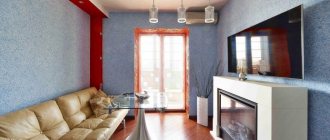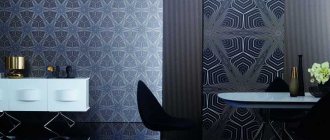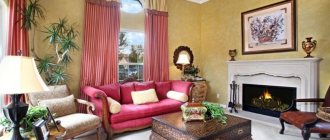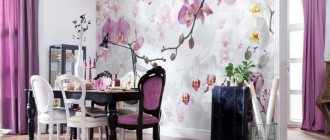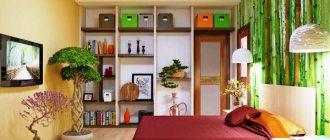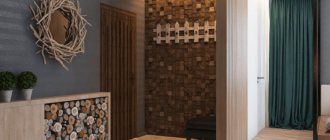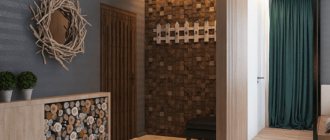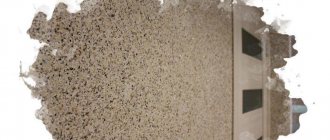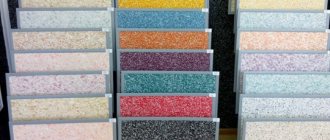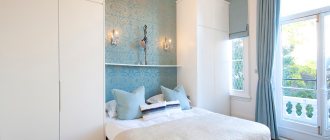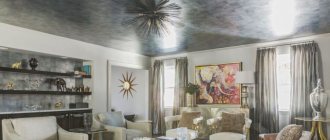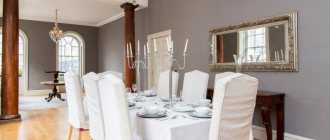What is liquid wallpaper?
There are opinions that liquid wallpaper is one of the variations of plaster for surface finishing or a combination of paper wallpaper with plaster. It is worth noting that these concepts cannot unambiguously answer the meaning of the term “liquid wallpaper”.
Wallpaper made from liquid materials may include elements of cotton and silk, mica, sand mixture of different grain sizes, and more.
They can be used for finishing home, office, and industrial premises, due to the varied color palette, abundance of textures and application of all kinds of patterns.
Gray liquid wallpaper
@dekorshtukaturka.ru
In finishing materials salons, compositions in this color scheme are often found. Moreover, consultants are able to provide the client with several shades to choose from. From the lightest to the darkest, almost black. The choice directly depends on the preferences of the apartment residents.
Gray liquid wallpaper can be an excellent backdrop for decorative inserts and elements in the interior of a room.
Pros and cons of gray
@Roomester.ru
The color is natural and calm. In nature, this is the shade of stones, gloomy skies, morning fog and dry land that has not seen rain for a long time. This is a static state of nature, when everything is stable and familiar.
Gray color is also perceived by the subconscious of the person in the room. It envelops you in calmness and awareness of stability. It’s not for nothing that many successful businessmen choose this tone for decorating office space and their offices.
Achromatic design can still depress and reduce the level of good mood and performance. This is the main disadvantage of gray. To avoid this, use bright details in your decor. Let these be small or barely noticeable, but eye-catching details.
Advantages and disadvantages of liquid wallpaper
The advantages of wallpaper made from liquid materials include: resistance to sub-zero temperatures and sudden temperature changes, resistance to fading in the sun, ease of application and rinsing from the surface, insulation from sounds.
This wallpaper is environmentally friendly. They can be used on surfaces that are difficult to access.
The disadvantages of such wallpaper are: use only in dry rooms, cleaning with dry rags, high cost.
Making liquid wallpaper with your own hands is quite simple. It is enough to have a large amount of paper and time in stock.
Flaws
It would seem like an ideal finishing option? But, like everywhere else, there are some nuances here.
- High price. This is not a budget material, unlike their “dry” counterparts; you won’t be able to buy a roll for 150 rubles.
- Good absorbency. And this is not an advantage - such a coating cannot be placed near wet places.
- Limited number of colors and textures. In fact, all options come down to a couple of textures and a small palette of colors, which in some interiors can be a serious disadvantage.
unsplash.com
- Decoration Materials
How to make liquid wallpaper with your own hands: choosing ingredients and a universal recipe
Master class - how to make liquid wallpaper with your own hands
- Shred paper (of any format, regardless of its purity) into small pieces measuring 3–4 centimeters.
- Fill the paper with water until it is completely covered. Leave until completely soaked, about 2 - 3 hours.
- Grind the soaked paper into a uniform mixture using a steel mixer.
- Add a color palette, plaster, glue (for 1 piece of paper - 1 teaspoon of plaster and 5 ml of glue). Mix. If necessary, add decorative elements (sand, mica and others).
- Apply to a previously prepared and dry surface with a layer of 3 – 4 mm. Let dry.
How to apply liquid wallpaper?
- Dilute the dry mixture according to the instructions and let it brew for 12 hours. Stir before use.
- It is better to stir the liquid mixture without using mechanisms, as this destroys the structure of the wallpaper.
- Use a metal spatula to evenly apply wallpaper to the surface.
- One surface should be made of one mixture to avoid visible transitions.
- The thickness of the wallpaper should not exceed 4 - 5 mm. For the initial layer - 2 - 3 mm, and for the final layer 2 mm.
- Allow the wallpaper to dry for 2 – 3 days.
Preparation of the composition
The solution to the problem of how to apply liquid wallpaper to paint with your own hands, as well as to any other surface, should begin by diluting the dry mixture.
The packaging of liquid wallpaper must contain instructions, which are best read before starting any work.
Briefly stated, it looks like this: The dry mixture is thoroughly mixed with warm, clean water (in cold liquid the composition will swell a little longer). If you want to add sparkles or mother-of-pearl, this must be done at the initial stage.
Knead the mass in a bucket or basin with your hands, achieving the consistency of mashed potatoes or very thick sour cream. Using a mixer is highly undesirable, since such mixing can damage the fibers of wallpaper and decorative elements.
After the composition has become uniform, it is transferred to a plastic bag and the container with the mixture is tightly tied or hermetically sealed. You can use the same bag. The wallpaper mixture will be ready in 8-12 hours, so it is better to start preparing it in the evening so that in the morning, with renewed vigor, you can rush into battle.
The entire package is diluted at once; the finished mass can be stored at room temperature for 3-4 days. So there is an opportunity to finish the walls without rushing too much. But there is no need to hesitate.
The remaining unused mixture is laid out in a thin layer on polyethylene, glass, stainless steel, dried for 24 hours, put in a bag and put in a dark and dry place. The composition will be useful if the wall requires repair.
Making drawings with liquid wallpaper
- Draw a sketch of the design with a pencil on the surface.
- Apply the mixture with a spatula along the outline of the sketch.
- Let the dates dry (3 – 4 hours). Apply a different color. Distribute the amount of mixture evenly.
An excellent solution when decorating the interior of a bedroom, children's room, or hallway would be to use wallpaper made from liquid materials.
The only rooms where such wallpaper should not be used are the kitchen and bathroom. In the kitchen there is a high probability of rapid contamination; in the bathroom there is high humidity.
Liquid wallpaper in the bedroom
To add warmth and comfort to the bedroom, you can add silk fiber to the liquid wallpaper.
The inclusion of shimmering elements in the mixture will create a unique stardust atmosphere.
Plaster with golden shimmer will add sophistication and luxury. Places that have cracks and unevenness will sparkle with a new golden light, which will give the room a unique depth with a brilliant glow.
Types of liquid wallpaper
Today, the building materials market offers a huge number of new liquid wallpaper products. In turn, they are divided into several types:
- Models with silk-screen printing. The product contains up to 50% silk threads, which after drying create a shiny texture. This option of decorative material is considered the most expensive among other types of liquid wallpaper;
- Paper and pulp. They are characterized by a short service life and the smallest amount of decorative materials. Their cost is much lower than that of silk models;
- Cotton. The presence of cotton particles makes the coating softer and more uniform;
- Models based on silk and cellulose. The composition uses silk and cellulose components;
- Moisture-resistant models. This type of decorative coating can be used to decorate a bathroom, bathhouse and even a sauna. These models use special additives that repel moisture and prevent its penetration into deep structures. The use of transparent acrylic varnish will help increase the water-repellent effect. To do this, it is enough to cover the walls with a thin layer to prolong the performance of the decorative coating. Caring for such walls is easy and simple. To do this, just wipe them with a soft cloth and soapy water.
Decorating a room for children
Decorating a room for children with wallpaper made from liquid materials looks richer and more comfortable compared to ordinary painting.
The room can be decorated with a design you and your baby like. Such wallpapers are safe and environmentally friendly. If your child colors the wallpaper, you can always update it.
RELEVANCE OF WALLPAPER WHEN FINISHING ROOMS FOR VARIOUS PURPOSE- Decorative brick wallpaper in the interior: types and design features (70+ photos)
How to choose armored doors
With the help of a variety of such wallpapers and the use of various elements in their composition, you can always make your room unique and designer stylish.
